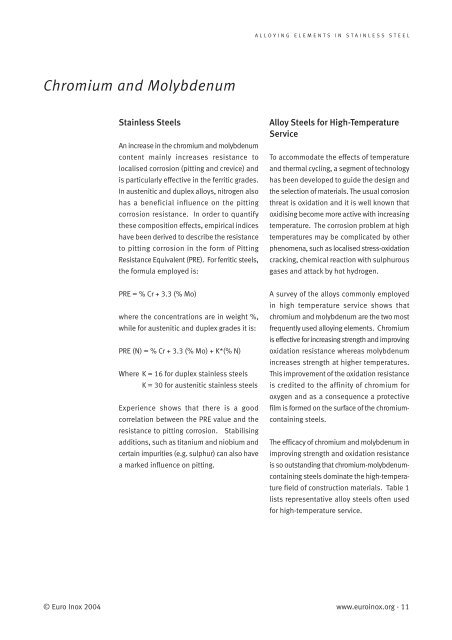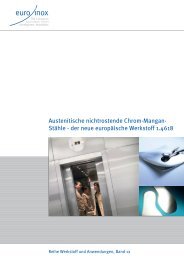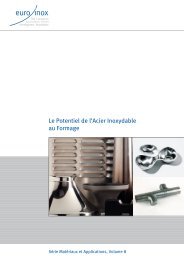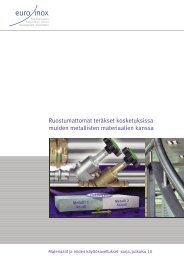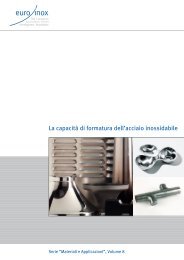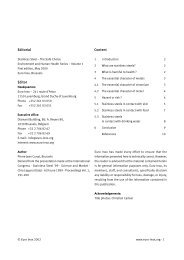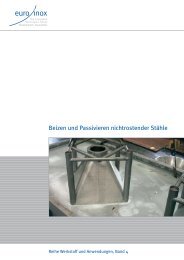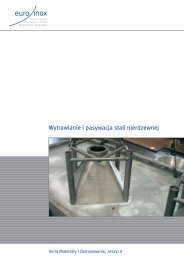Alloying Elements in Stainless Steel and Other Chromium - Euro Inox
Alloying Elements in Stainless Steel and Other Chromium - Euro Inox
Alloying Elements in Stainless Steel and Other Chromium - Euro Inox
You also want an ePaper? Increase the reach of your titles
YUMPU automatically turns print PDFs into web optimized ePapers that Google loves.
<strong>Chromium</strong> <strong>and</strong> Molybdenum<br />
© <strong>Euro</strong> <strong>Inox</strong> 2004<br />
Sta<strong>in</strong>less <strong>Steel</strong>s<br />
An <strong>in</strong>crease <strong>in</strong> the chromium <strong>and</strong> molybdenum<br />
content ma<strong>in</strong>ly <strong>in</strong>creases resistance to<br />
localised corrosion (pitt<strong>in</strong>g <strong>and</strong> crevice) <strong>and</strong><br />
is particularly effective <strong>in</strong> the ferritic grades.<br />
In austenitic <strong>and</strong> duplex alloys, nitrogen also<br />
has a beneficial <strong>in</strong>fluence on the pitt<strong>in</strong>g<br />
corrosion resistance. In order to quantify<br />
these composition effects, empirical <strong>in</strong>dices<br />
have been derived to describe the resistance<br />
to pitt<strong>in</strong>g corrosion <strong>in</strong> the form of Pitt<strong>in</strong>g<br />
Resistance Equivalent (PRE). For ferritic steels,<br />
the formula employed is:<br />
PRE = % Cr + 3.3 (% Mo)<br />
where the concentrations are <strong>in</strong> weight %,<br />
while for austenitic <strong>and</strong> duplex grades it is:<br />
PRE (N) = % Cr + 3.3 (% Mo) + K*(% N)<br />
Where K = 16 for duplex sta<strong>in</strong>less steels<br />
K= 30 for austenitic sta<strong>in</strong>less steels<br />
Experience shows that there is a good<br />
correlation between the PRE value <strong>and</strong> the<br />
resistance to pitt<strong>in</strong>g corrosion. Stabilis<strong>in</strong>g<br />
additions, such as titanium <strong>and</strong> niobium <strong>and</strong><br />
certa<strong>in</strong> impurities (e.g. sulphur) can also have<br />
a marked <strong>in</strong>fluence on pitt<strong>in</strong>g.<br />
ALLOYING ELEMENTS IN STAINLESS STEEL<br />
Alloy <strong>Steel</strong>s for High-Temperature<br />
Service<br />
To accommodate the effects of temperature<br />
<strong>and</strong> thermal cycl<strong>in</strong>g, a segment of technology<br />
has been developed to guide the design <strong>and</strong><br />
the selection of materials. The usual corrosion<br />
threat is oxidation <strong>and</strong> it is well known that<br />
oxidis<strong>in</strong>g become more active with <strong>in</strong>creas<strong>in</strong>g<br />
temperature. The corrosion problem at high<br />
temperatures may be complicated by other<br />
phenomena, such as localised stress-oxidation<br />
crack<strong>in</strong>g, chemical reaction with sulphurous<br />
gases <strong>and</strong> attack by hot hydrogen.<br />
A survey of the alloys commonly employed<br />
<strong>in</strong> high temperature service shows that<br />
chromium <strong>and</strong> molybdenum are the two most<br />
frequently used alloy<strong>in</strong>g elements. <strong>Chromium</strong><br />
is effective for <strong>in</strong>creas<strong>in</strong>g strength <strong>and</strong> improv<strong>in</strong>g<br />
oxidation resistance whereas molybdenum<br />
<strong>in</strong>creases strength at higher temperatures.<br />
This improvement of the oxidation resistance<br />
is credited to the aff<strong>in</strong>ity of chromium for<br />
oxygen <strong>and</strong> as a consequence a protective<br />
film is formed on the surface of the chromiumconta<strong>in</strong><strong>in</strong>g<br />
steels.<br />
The efficacy of chromium <strong>and</strong> molybdenum <strong>in</strong><br />
improv<strong>in</strong>g strength <strong>and</strong> oxidation resistance<br />
is so outst<strong>and</strong><strong>in</strong>g that chromium-molybdenumconta<strong>in</strong><strong>in</strong>g<br />
steels dom<strong>in</strong>ate the high-temperature<br />
field of construction materials. Table 1<br />
lists representative alloy steels often used<br />
for high-temperature service.<br />
www.euro<strong>in</strong>ox.org · 11


